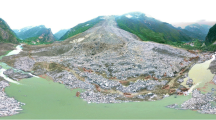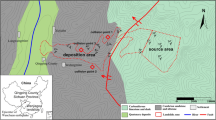Abstract
The discrete element method is well suited for simulating the cracks and subsequent large displacements of catastrophic landslides or rock avalanches, and is therefore a useful tool for analysing their complicated dynamic processes and hypermobility mechanisms. In this study, particle flow code was used to investigate the dynamic processes and hypermobility mechanisms of the Wenjiagou rock avalanche triggered by the 2008 Wenchuan earthquake. Characterization of the avalanche dynamics was achieved using a model comprising four stages: failure rupture, projectile motion, granular debris flow, and debris mass accumulation. The results show that collision on the valley floor was the main factor causing the fragmentation of the Wenjiagou rock avalanche. The upper and front edge of the landslide body were the most likely to move over a long distance. The results also show that friction was the main source of energy dissipation during the entirety of the avalanche movement. The high gravitational potential energy of the avalanche was the basis of the high mobility. In addition, because of their effects on energy dissipation, the low basal friction coefficient, favourable block movement, and topographical conditions played key roles in the rapid, long-runout Wenjiagou avalanche process.

















Similar content being viewed by others
References
Ayotte D, Hungr O (2000) Calibration of a runout prediction model for debris-flows and avalanches. In: Proceedings of the 2nd international conference on debris-flow hazards mitigation: mechanics, prediction, and assessment. Taipei, Taiwan, pp 505–514
Cundall P (1971) A computer model for simulating progressive, large-scale movements in blocky rock systems. In: Proceedings of international symposium on rock fracture, pp 11–18
Cundall PA, Strack OD (1979) A discrete numerical model for granular assemblies. Geotechnique 29:47–65
Davies TR (1982) Spreading of rock avalanche debris by mechanical fluidization. Rock Mech 15:9–24
Davies T, McSaveney M (2009) The role of rock fragmentation in the motion of large landslides. Eng Geol 109:67–79
Davies T, McSaveney M, Hodgson K (1999) A fragmentation-spreading model for long-runout rock avalanches. Can Geotech J 36:1096–1110
Deline P (2009) Interactions between rock avalanches and glaciers in the Mont Blanc massif during the late Holocene. Quat Sci Rev 28:1070–1083
Dufresne A, Davies T (2009) Longitudinal ridges in mass movement deposits. Geomorphology 105:171–181
Dykes AP, Warburton J (2007) Mass movements in peat: a formal classification scheme. Geomorphology 86:73–93
Eisbacher G (1979) Cliff collapse and rock avalanches (sturzstroms) in the Mackenzie Mountains, northwestern Canada. Can Geotech J 16:309–334
Erismann T (1979) Mechanisms of large landslides. Rock Mech 12:15–46
Giani GP (1992) Rock slope stability analysis. Balkema, Rotterdam
Havenith H-B, Strom A, Jongmans D, Abdrakhmatov A, Delvaux D, Tréfois P (2003) Seismic triggering of landslides, part A: field evidence from the Northern Tien Shan. Nat Hazards Earth Syst Sci 3:135–149
Hoek E (1994) Strength of rock and rock masses. ISRM News J 2:4–16
Hoek E, Diederichs MS (2006) Empirical estimation of rock mass modulus. Int J Rock Mech Min Sci 43:203–215
Hoek E, Carranza-Torres C, Corkum B (2002) Hoek-Brown failure criterion—2002 edition. Proc NARMS-Tac 1:267–273
Hsü KJ (1975) Catastrophic debris streams (sturzstroms) generated by rockfalls. Geol Soc Am Bull 86:129–140
Huang Y, Zhang W-J, Xu Q, Xie P, Hao L (2012) Run-out analysis of flow-like landslides triggered by the Ms 8.0 2008 Wenchuan earthquake using smoothed particle hydrodynamics. Landslides 9:275–283
Huang H-Q, Zhao Q-H, Li X-L (2015a) The analysis of dynamics characteristics of large-scale wenjiagou landslide-sturzstrom triggered by wenchuan earthquake. In: Lollino G, Giordan D, Crosta BG, Corominas J, Azzam R, Wasowski J, Sciarra N (eds) Engineering geology for society and territory, vol 2. Landslide processes, Springer International Publishing, Cham, pp 697–702
Huang Y, Cheng H-L et al (2015b) SPH-based numerical simulation of catastrophic debris flows after the 2008 Wenchuan earthquake. Bull Eng Geol Environ 74:1137–1151
Hungr O, Evans S, Bovis M, Hutchinson J (2001) A review of the classification of landslides of the flow type. Environ Eng Geosci 7:221–238
Kent P (1966) The transport mechanism in catastrophic rock falls. J Geol 74:79–83
Knapp S, Mamot P, Krautblatter M (2015) The mobility of rock avalanches: disintegration, entrainment and deposition—a conceptual approach. In: EGU general assembly conference abstracts, vol 17. EGU2015-12496. EGU General Assembly, Vienna
Legros F (2002) The mobility of long-runout landslides. Eng Geol 63:301–331
Liang Y (2014) Study on Wenjiagou landslide characteristics based on remote sensing image. Dissertation, China University of Geosciences (Beijing) (in chinese)
Lo C-M, Lin M-L, Tang C-L, Hu J-C (2011) A kinematic model of the Hsiaolin landslide calibrated to the morphology of the landslide deposit. Eng Geol 123:22–39
Lo C-M, Lee C-F, Chou H-T, Lin M-L (2014) Landslide at Su-Hua highway 115.9k triggered by Typhoon Megi in Taiwan. Landslides 11:293–304
Lu C-Y, Tang C-L, Chan Y-C, Hu J-C, Chi C-C (2014) Forecasting landslide hazard by the 3D discrete element method: a case study of the unstable slope in the Lushan hot spring district, central Taiwan. Eng Geol 183:14–30
Nicoletti PG, Sorriso-Valvo M (1991) Geomorphic controls of the shape and mobility of rock avalanches. Geol Soc Am Bull 103:1365–1373
Nishii R, Matsuoka N (2012) Kinematics of an alpine retrogressive rockslide in the Japanese Alps. Earth Surf Proc Land 37:1641–1650
Okura Y, Kitahara H, Sammori T, Kawanami A (2000) The effects of rockfall volume on runout distance. Eng Geol 58:109–124
Poisel R, Roth W (2004) Run out models of rock slope failures. Felsbau 22:46–50
Poisel R, Preh A, Hungr O (2008) Run out of landslides—continuum mechanics versus discontinuum mechanics models. Geomech Tunn 1:358–366
Potyondy D, Cundall P (2004) A bonded-particle model for rock. Int J Rock Mech Min Sci 41:1329–1364
Saiang D (2008) Determination of specific rock mass failure envelope via PFC and its subsequent application using FLAC. In: Proceedings of the 1st international FLAC/DEM symposium on numerical modelling, Minneapolis, USA. Itasca Consulting Group
Shreve RL (1966) Sherman landslide, Alaska. Science 154:1639–1643
Sosio R, Crosta GB, Hungr O (2008) Complete dynamic modeling calibration for the Thurwieser rock avalanche (Italian Central Alps). Eng Geol 100:11–26
Stead D, Eberhardt E, Coggan J (2006) Developments in the characterization of complex rock slope deformation and failure using numerical modelling techniques. Eng Geol 83:217–235
Tang C-L, Hu J-C, Lin M-L, Angelier J, Lu C-Y, Chan Y-C, Chu H-T (2009) The Tsaoling landslide triggered by the Chi-Chi earthquake, Taiwan: insights from a discrete element simulation. Eng Geol 106:1–19
Tang Y, Zhang Z, Wang C, Zhang H, Wu F, Liu M (2015) Characterization of the giant landslide at Wenjiagou by the insar technique using TSX-TDX CoSSC data. Landslides 12:1015–1021
Thompson N, Bennett MR, Petford N (2009) Analyses on granular mass movement mechanics and deformation with distinct element numerical modeling: implications for large-scale rock and debris avalanches. Acta Geotech 4:233–247
Wang T, Shi J-S, Wu S-R, Zhang Y-S, Li B, Xin P, Sun P (2010) Formation mechanism of Wenjiagou high speed and long runout debris avalanche triggered by Wenchuan earth quake. J Eng Geol 18:631–644 (in Chinese)
Wu S-R, Wang T et al (2010) Study on catastrophic landslides triggered by 2008 Great Wenhcuan Earthquake, Sichuan, China. J Eng Geol 18:145–159 (in Chinese)
Yin Y, Wang F, Sun P (2009) Landslide hazards triggered by the 2008 Wenchuan earthquake, Sichuan, China. Landslides 6:139–152
Yuan R-M, Xu X-W, Chen G-H, Tan X-B, Klinger Y, Xing H-L (2010) Ejection landslide at northern terminus of Beichuan rupture triggered by the 2008 Mw 7.9 Wenchuan earthquake. Bull Seismol Soc Am 100:2689–2699
Yuan R-M, Tang C-L, Hu J-C, Xu X-W (2014) Mechanism of the Donghekou landslide triggered by the 2008 Wenchuan earthquake revealed by discrete element modeling. Nat Hazards Earth Syst Sci 14:1195–1205
Zhang M, Yin Y-P (2013) Dynamics, mobility-controlling factors and transport mechanisms of rapid long-runout rock avalanches in China. Eng Geol 167:37–58
Zhang M, Yin Y-P, Wu S-R, Zhang Y-S, Han J-L (2011) Dynamics of the Niumiangou Creek rock avalanche triggered by 2008 Ms 8.0 Wenchuan earthquake, Sichuan, China. Landslides 8:363–371
Zhang M, Yin Y-P, McSaveney M (2016) Dynamics of the 2008 earthquake-triggered Wenjiagou Creek rock avalanche, Qingping, Sichuan, China. Eng Geol 200:75–87
Zhou J-W, Cui P, Fang H (2013) Dynamic process analysis for the formation of Yangjiagou landslide-dammed lake triggered by the Wenchuan earthquake, China. Landslides 10:331–342
Zhou J-W, Huang K-X, Shi C, Hao M-H, Guo C-X (2015) Discrete element modeling of the mass movement and loose material supplying the gully process of a debris avalanche in the Bayi Gully, Southwest China. J Asian Earth Sci 99:95–111
Acknowledgments
This work was supported by the National Natural Science Foundation of China (grant nos. 41272298 and 41372290).
Author information
Authors and Affiliations
Corresponding author
Rights and permissions
About this article
Cite this article
Deng, Q., Gong, L., Zhang, L. et al. Simulating dynamic processes and hypermobility mechanisms of the Wenjiagou rock avalanche triggered by the 2008 Wenchuan earthquake using discrete element modelling. Bull Eng Geol Environ 76, 923–936 (2017). https://doi.org/10.1007/s10064-016-0914-2
Received:
Accepted:
Published:
Issue Date:
DOI: https://doi.org/10.1007/s10064-016-0914-2




